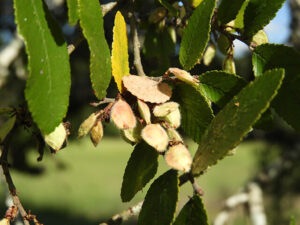Focus on a Native: Cedar Elm
by CMG Betty J
The Cedar Elm tree, Ulmus crassifolia, is a highly adaptable, deciduous native tree that is found throughout the Texas Hill Country, especially in areas with caliche soil or well-drained loam. Its dense branch and leaf structure provide good shade for a patio or yard. In full sunlight, it will grow at a medium rate (about one – two feet per year) and often reach a height of over 70’ in zones 6-9. Cedar Elms are notoriously drought tolerant but also live successfully in areas that flood periodically.
Unlike many trees that bloom in spring, Cedar Elms blossom in late summer and occasionally, as late as October. There is sometimes confusion about whether a tree is a Cedar Elm or a Winged Elm, but the bloom time will help with identification. Winged Elms bloom in spring. Cedar Elm has ridged bark with loose scales and the new branches of young trees grow flanges, (wings), like a Winged Elm. Winged Elms have flanges at all stages of growth and do not grow readily in the Hill Country.

Cedar Elm Winged Branches
The leaves are dark green, 1-2” long, simple, elliptical with finely toothed edges and have a rough texture. They turn golden yellow in the autumn. The flower clusters produce oval seeds called samara in which the seed is in the center of a “wing” that will catch the wind and help distribute the seeds. Turkeys, quail, deer, squirrels, and songbirds all eat these seeds. It is the larval host to Mourning Cloak and Question Mark butterflies.

Developing Cedar Elm Samaras

Cedar Elm Leaves
Also known as Fall Elm, Basket Elm, Scrub Elm, Lime Elm and Texas Elm, Cedar Elms are likely called that because they frequently grow with Ashe Juniper trees (known locally as cedars). They are available for landscape planting at local nurseries. Sometimes nurseries mislabel the trees, confusing the Cedar Elm and The Winged Elm. To determine if your selection is a true Cedar Elm, rub the leaves and if they are rough, it is a Cedar Elm.
Unfortunately, Dutch elm disease has been diagnosed in Cedar Elms in some north Texas counties. The cases have been isolated and studies have shown that this species of elm may be less susceptible to oak wilt than other species. The Lady Byrd Johnson Wildflower Center page indicates no real pest or disease problems at present.